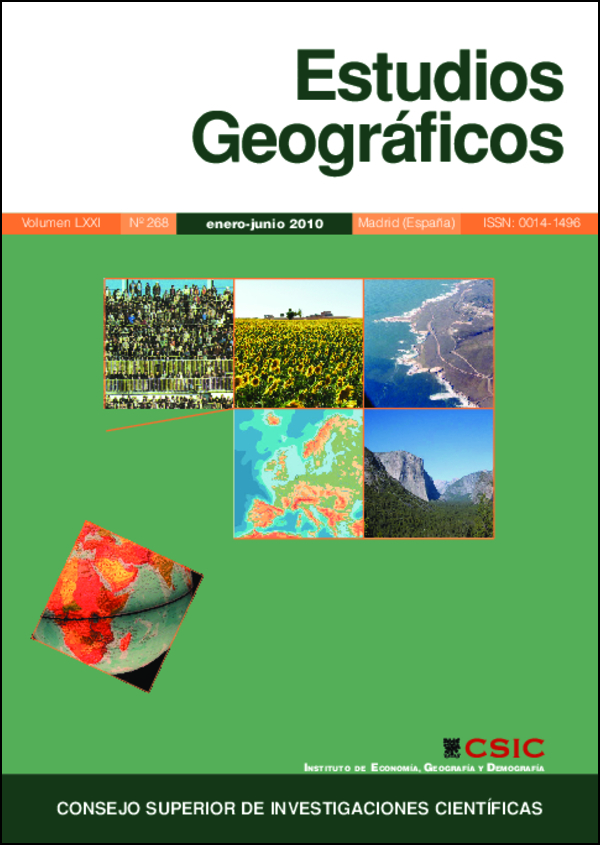Segregation and distribution of foreign immigrant population in Seville (2000-2008)
DOI:
https://doi.org/10.3989/estgeogr.0470Keywords:
inmigration, foreign population, social geography, segregation, clustersAbstract
In this decade, foreign immigration has increased its weight in the town of Seville. In the recent past, this had a marginal effect on Seville´s population, but nowadays it has become a fact of a great social and demographic importance. From a quantitative methodology, this article seeks to make a synthetic approach to the demographic impact of the increase of foreign population, as well as its distribution and segregation in the city, and the possible formation of clusters in certain urban areas. With this goal, we have worked with the municipal files of the city and mapped these realities, using some common indicators and techniques and some others less used by Spanish social scientists.
Downloads
References
Anselin, L.: “Local indicators of spatial Association-LISA”. Geographical Analysis, vol. 27, nº 2, 1995, pp. 93-115.
Anselin, L.: “The Moran Scatter plot as an ESDA Tool to Assess Local Instability in Spatial Association” Communication en el GISDATA Specialist Meeting on GIS and Spatial Analysis, Holanda, 1-5 de diciembre de 1993.
Bayona, J.: “La segregación residencial de la población extranjera en Barcelona: ¿una segregación fragmentada?” Scripta Nova. Revista Electrónica de Geografía y Ciencias sociales, vol. XI, núm. 235, 15 de marzo de 2007.
Díaz, I.: “Movimientos vecinales contra la gentrificación y transformaciones en la política local de Sevilla. Los casos de El Pumarejo y San Bernardo”. Actas del X Coloquio Internacional de Geocrítica. Universidad de Barcelona, 26-30 de mayo de 2008.
Duncan, O. D. y Duncan, B.: “A methodological analysis of segregation indexes.” American Sociological Review, vol. 41, 1955a, pp. 210-217. doi:10.2307/2088328
Duncan, O. D. y Duncan, B.: “Residencial distribution and occupational stratification”. The american journal of sociology, vol. 60, nº 5, 1955b, pp. 493-503. doi:10.1086/221609
Duncan, O. D. y Lieberson, S.: “Ethnic Segregation and Assimilation”. The American Journal of Sociology, vol. 64, nº 4, 1959, pp. 364-347. doi:10.1086/222496
Escolano, S.: “La medida de la segregación residencial urbana: análisis multiescala mediante índices de lagunaridad”. Geofocus, nº 7, 2007, pp. 216-234.
Martínez, A. y Leal, J.: “La segregación residencia, un indicador espacial confuso en la representación de la problemática residencial de los inmigrantes económicos: el caso de la Comunidad de Madrid”. Arquitectura, Ciudad y Entorno. Año III, nº 8, 2008.
Martori, J. C., Hoberg, K. y Surinach, J.: “Población inmigrante y espacio urbano. Indicadores de segregación y pautas de localización” Revista Eure, vol. XXXII, nº 97, 2006, pp. 49-62.
Martori, J. C., Hoberg, K. y Madariaga, R.: “La incorporación del espacio en los métodos estadísticos: autocorrelación espacial y segregación”. Actas del X Coloquio Internacional de Geocrítica. Universidad de Barcelona, 26-30 de mayo de 2008.
Martori, J. C. y Hoberg, K.: “Nuevas técnicas de estadística espacial para la detección de clústeres residenciales de población inmigrante”. Scripta Nova, vol. XII, nº 261, 2008.
Martori, J. C.; Hoberg, K.: “Indicadores cuantitativos de segregación residencial. El caso de la población inmigrante en Barcelona”. Scripta Nova, vol. VIII, nº 169, 2004.
Messner, S. y Anselin, L.: “Spatial Analyses of Homicide with Areal Data”, pp. 127-144. Goodchild, M. y G. Janelle, D. (ed.): Spatially Integrated Social Science. University Press, 2004, Oxford.
Moreno, R. y Vayá, E.: Técnicas econométricas para el tratamiento de datos espaciales. Universitat de Barcelona, Barcelona, 2000.
PNUD: Informe sobre desarrollo humano 2007/2008. Mundi-Prensa Libros, s. a., 2007, Madrid.
Urdiales, Mª E.: “Disección de la inmigración en España en base al padrón municipal de 2007.” Biblio 3W, vol. XII, nº 762, 2007.
Downloads
Published
How to Cite
Issue
Section
License
Copyright (c) 2010 Consejo Superior de Investigaciones Científicas (CSIC)

This work is licensed under a Creative Commons Attribution 4.0 International License.
© CSIC. Manuscripts published in both the print and online versions of this journal are the property of the Consejo Superior de Investigaciones Científicas, and quoting this source is a requirement for any partial or full reproduction.
All contents of this electronic edition, except where otherwise noted, are distributed under a Creative Commons Attribution 4.0 International (CC BY 4.0) licence. You may read the basic information and the legal text of the licence. The indication of the CC BY 4.0 licence must be expressly stated in this way when necessary.
Self-archiving in repositories, personal webpages or similar, of any version other than the final version of the work produced by the publisher, is not allowed.















